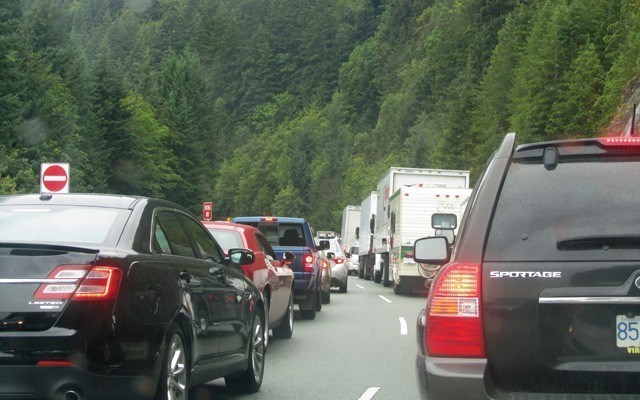Whistler’s greenhouse gas (GHG) emissions rose four per cent in 2019, which only lends more urgency to the Resort Municipality of Whistler’s (RMOW) new Climate Action Big Moves Strategy, according to a report to council on Sept. 1.
The report from climate action coordinator Luisa Burhenne shows Whistler’s GHG emissions (both corporate and community) totalled 131,166 tonnes of carbon dioxide equivalent in 2019—a four-per-cent increase over 2018.
Passenger vehicle emissions continue to be the worst polluter, accounting for 54 per cent of Whistler’s GHG emissions, followed by natural gas at 35 per cent.
Community energy consumption was also up three per cent year over year.
On the corporate side, direct GHG emissions from Resort Municipality of Whistler operations decreased five per cent, while emissions from contractors saw a 55-per-cent increase, attributed by Burhenne to “the inclusion of solid waste transportation to the Surrey rail yard from where it is transported to the Rabanco landfill.”
“How do we get back on track? There are three components to that,” Burhenne said, adding that it will take accelerated action (to hit the RMOW’s new target of a 50-per-cent emissions reduction by 2030), accountability (including developing a GHG impact tool for use with municipal projects) and leadership at the corporate level.
Earlier this year, council reversed course on a longstanding policy to not procure asphalt from the Alpine Paving plant in Cheakamus Crossing, with one reason cited being the GHG emissions produced from trucking asphalt up from Squamish, which Whistler has done since 2011.
In that time, emissions from asphalt trucks have produced 270 tonnes of CO2, equal to the annual output of about 55 passenger vehicles.
But every inch counts, and the RMOW needs to lead by example, Burhenne said.
“We have to show this is possible,” she said.
“We have to work on our own buildings and vehicles first, and to do so, I will be updating the RMOW climate neutral operations plan and setting new targets to reduce our own RMOW GHG emissions.”
The report also includes an update on Whistler’s Community Energy and Climate Action Plan (CECAP).
As of Q2 2020, nine of its initiatives are now completed, 31 are ongoing, 67 are in progress and 27 are not yet initiated.
This represents a small change from Q4 2019, where eight initiatives were completed, 30 were ongoing, 68 in progress and 27 not yet initiated.
“As local governments we need depth of incentives and disincentives, carrots and sticks, to move the dial on climate, and I really hope in my term that we will be enabled to legislate greenhouse gas (and) waste reduction,” said Councillor Arthur De Jong.
The lack of legislative teeth for municipalities when it comes to GHGs and waste has long been a sore sport for De Jong, and one shared by Mayor Jack Crompton.
“I’ve never been a person who felt that it was legitimate for local government people to say ‘it’s not my job,’” Crompton said.
“It’s our job to convince [other levels of government] that they should act, and I hope that this group of people takes it upon ourselves to really make that case to the people who have the levers to make the changes that we need to make.”
The RMOW has tracked both its own corporate emissions and those of the entire community since 2000, with all reports since 2010 available online at whistler.ca/climate.
Whistler has one of the longest histories in the province of both setting emissions reductions targets and actively monitoring its GHG emissions footprint at the local government level, a spokesperson said in response to questions about the RMOW’s monitoring standards.
“These reports are diligently put together with a thorough internal verification process that is consistent with provincial reporting requirements and submitted to the province annually,” the spokesperson said.
“There are no external, or third-party reviews/verifications required by the province for B.C. local governments.”




